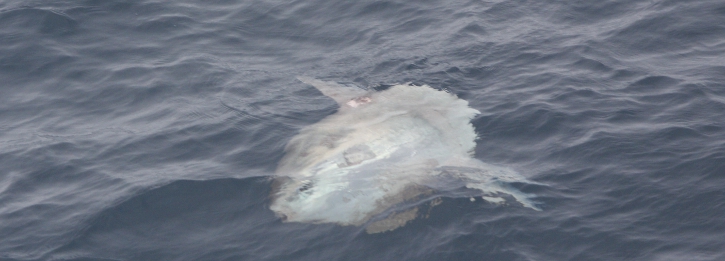In This Section
A winter in Ireland: Irish scientists uncover habits of the large and elusive Ocean sunfish

The largest bony fish in the world, the ocean sunfish, has been found to occur in Irish waters year round and in much higher numbers than previously thought
Scientists from University College Cork’s School of Biological, Earth & Environmental Science and the MaREI Centre for Marine and Renewable Energy, in collaboration with researchers in Spain and the Netherlands have uncovered new insights into the ecology of Ocean sunfish inhabiting Ireland’s offshore waters.
The Ocean sunfish is the largest bony fish in the world, with adults often growing up to 3m in length and weighing up to a tonne. But, despite being found in oceans across the world, little is known about their numbers or movements throughout the year. Sunfish are sometimes seen from boats in Irish waters in the summer time, when they are thought to migrate to these waters to feed on the rich jellyfish blooms which occur here. However, their wider distribution and movements during the winter months have been more of a mystery; until now…
Our first publication on the large and elusive ocean sunfish has been published in @SciReports https://t.co/e4hJfVK3rD
— OBSERVE Aerial (@OBSERVEaerial) May 18, 2017
Under the ObSERVE Aerial project, the research group spent a year surveying Ireland’s offshore waters from a specialised aeroplane. They flew over 17,000 km of surveys during the summer and winter, extending out to 300km from the Irish coast recording observations of sunfish. Speaking about the research, Dr Patricia Breen, the lead author of the study stated that “This is the first time we have had any comprehensive offshore survey effort in good weather during the winter months, and the data we have collected will be important to determine the numbers and distribution of many protected marine species during the winter period”
The study presents the first abundance estimates of Ocean sunfish in Irish waters. Contrary to the belief that these fish are relatively rare in Irish waters, the team calculated that there were a minimum of 12,700 sunfish offshore during summer, but interestingly, over 8,200 individuals in winter. Dr Breen stated “Previous to our surveys these fish were presumed to have migrated south to warmer waters in the autumn. This is the first published record of their widespread presence in Irish waters in the winter. Because sunfish spend upwards of 80% of their time below the surface where we can’t see them, both summer and winter estimates represent minimum estimates”. The study identified several key areas of high sunfish density that are likely to reflect the distribution of their jellyfish prey. Sunfish need to consume large amounts of prey to develop and maintain their great bulk, and the study estimated that sunfish in Irish waters consume around 2,600 tonnes of jellyfish per day. Dr Mark Jessopp, a marine ecologist and co-author of the study added “This makes sunfish an incredibly important part of the marine ecosystem, and they are likely to play a largely unrecognised but important role in controlling large jellyfish blooms.”
2/6 Very pleased to see my latest paper on ocean sunfish published in @SciReports https://t.co/1QhQsLB6Zt
— Patricia Breen (@PatriciaABreen) May 18, 2017
Their presence here in winter has also uncovered new insights into their ability to withstand colder sea temperatures. Until now research has suggested that sunfish are most often found in warmer waters with the previous lowest recorded temperature around 10°C. “The lowest recorded sea surface temperature in our study was 8°C, which is below the previously known threshold. This finding is not a total surprise, given what we know about their ability to dive to depths of up to 700m where they would regularly encounter such temperatures, but it does provide new information on the overall range of these animals in that we found them at much higher latitudes than previously thought” Dr Breen added.
Research finds ocean sunfish, up to 3m in length, are regular visitors to Irish coast https://t.co/D5NqP4L0SB
— The Irish Times (@IrishTimes) May 18, 2017
Considering that sunfish are accidentally but frequently caught in gill and driftnet fisheries, in order to maintain the important role they play in the ecosystem efforts should be made to conserve them through reducing bycatch. Professor Emer Rogan, a co-author of the study stated that “Studies such as this one are fundamental to our efforts to ensure the population of sunfish in Ireland is properly managed and conserved”.
The ObSERVE Programme is funded by the Department of Communications, Climate Action and Environment (DCCAE) in partnership with the Department of Arts, Heritage, Regional, Rural and Gaeltacht Affairs (DAHRRGA). The ObSERVE Aerial project partners are University College Cork, Alnilam based in Spain, and IMARES based in the Netherlands.
To read the full article in Scientific Reports visit: www.nature.com/articles/s41598-017-02103-6
School of Biological, Earth and Environmental Sciences
An Scoil Eolaíochtaí Bitheolaíocha, Domhaneolaíocha agus Comhshaoil
Contact us
Distillery Fields, North Mall, University College Cork, Ireland , T23 TK30
